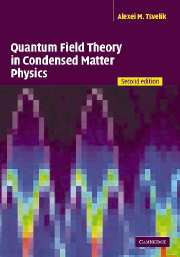Book contents
- Frontmatter
- Contents
- Preface to the first edition
- Preface to the second edition
- Acknowledgements for the first edition
- Acknowledgements for the second edition
- I Introduction to methods
- 1 QFT: language and goals
- 2 Connection between quantum and classical: path integrals
- 3 Definitions of correlation functions: Wick's theorem
- 4 Free bosonic field in an external field
- 5 Perturbation theory: Feynman diagrams
- 6 Calculation methods for diagram series: divergences and their elimination
- 7 Renormalization group procedures
- 8 O(N)-symmetric vector model below the transition point
- 9 Nonlinear sigma models in two dimensions: renormalization group and 1/N-expansion
- 10 O(3) nonlinear sigma model in the strong coupling limit
- II Fermions
- III Strongly fluctuating spin systems
- IV Physics in the world of one spatial dimension
- Select bibliography
- Index
7 - Renormalization group procedures
Published online by Cambridge University Press: 05 May 2010
- Frontmatter
- Contents
- Preface to the first edition
- Preface to the second edition
- Acknowledgements for the first edition
- Acknowledgements for the second edition
- I Introduction to methods
- 1 QFT: language and goals
- 2 Connection between quantum and classical: path integrals
- 3 Definitions of correlation functions: Wick's theorem
- 4 Free bosonic field in an external field
- 5 Perturbation theory: Feynman diagrams
- 6 Calculation methods for diagram series: divergences and their elimination
- 7 Renormalization group procedures
- 8 O(N)-symmetric vector model below the transition point
- 9 Nonlinear sigma models in two dimensions: renormalization group and 1/N-expansion
- 10 O(3) nonlinear sigma model in the strong coupling limit
- II Fermions
- III Strongly fluctuating spin systems
- IV Physics in the world of one spatial dimension
- Select bibliography
- Index
Summary
The topic of this chapter is one of the most beautiful and profound concepts in QFT: the concept of criticality, renormalization and scaling. This concept is relevant for systems which have no natural intrinsic scale. In the theory we have been discussing so far, the O(N)-symmetric vector field model, there is such a scale: it is the inverse mass m−1. The correlation functions decay exponentially at distances (or time scales) larger then m−1. Mean while there are extrinsic scales both large and small in the theory: the large scales are 1/T and the size of the system L, and the small scale is a, the lattice size. If we have an intrinsic scale we can apply it to all external agents acting on the system and make qualitative estimates of their strength. However, imagine that m → 0; it seems that the system becomes self-similar on all scales.
Let me give an example of what I mean by self-similar. This example is not taken from physics, but from social institutions. Imagine such a venerable system as an army. An army has a hierarchical structure represented as a collection of units of different size. All this structure is united under the principles of seniority of ranks and subordination of lower ranks to the senior. These principles form a pattern for relations between army personnel inside units of any size. This pattern is very similar for relations between a soldier and a sergeant inside the smallest unit and for relations between a lieutenant of this unit and a captain of the platoon, and between this captain and his colonel, etc.
- Type
- Chapter
- Information
- Quantum Field Theory in Condensed Matter Physics , pp. 56 - 65Publisher: Cambridge University PressPrint publication year: 2003

